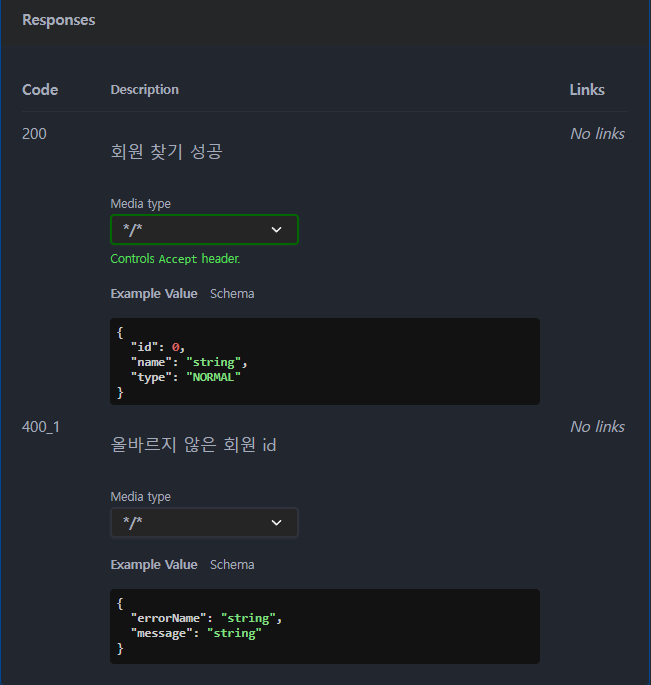1.build.gradle
implementation 'org.springdoc:springdoc-openapi-ui:1.7.0'2.application.properties
springdoc.swagger-ui.path=/swagger-ui.html
#swagger 접속 주소 ex) localhost:8080/swagger-ui.html
springdoc.swagger-ui.groups-order=asc
#swagger group 정렬 순서 desc,asc
springdoc.swagger-ui.operations-sorter=
# method순으로 정렬Reference
https://springdoc.org/properties.html
Springdoc-openapi Properties
springdoc-openapi core properties Parameter name Default Value Description springdoc.api-docs.path /v3/api-docs String, For custom path of the OpenAPI documentation in Json format. springdoc.api-docs.enabled true Boolean. To disable the springdoc-openapi e
springdoc.org
3.annotation
(1) api 그룹 설정:@Tag
@Tag(name = "member",description = "사용자 API")
public class MemberController {
...
}
name:그룹 이름
description:그룹 설명
@Tag에 설정된 name이 같은 것끼리 하나의 api그룹이 생성됩니다.
(2) api Schema 설정 : @Schema
@Getter
@NoArgsConstructor
public class MemberSaveDto {
@NotBlank(message = "이름을 입력해주세요")
@Schema(description = "유저이름")
private String name;
}

각 필드에 여러가지 설명을 붙일 수 있습니다.
description:각 필드의 설명
defaultValue:기본 값
allowValues:허용 값 ex) {1,2}
minlength:최소 길이
maxlength:최대 길이
hidden:필드 숨기기
등 많은 옵션을 제공합니다.
3. api 상세 정보 설정:@Operation
@GetMapping("/members/{memberId}")
@Operation(summary = "회원 찾기" , description = "회원의 id을 받아 회원을 찾습니다.")
public ResponseEntity<Member> findMember(@PathVariable Long memberId){
return new ResponseEntity<>(memberService.findMember(memberId), HttpStatus.CREATED);
}
summary: api에 대한 간략 설명
description : api에 대한 상세 설명
responses : api Response 리스트
parameters : api 파라미터 리스트
4. api response 설정 : @ApiResponse
@GetMapping("/members/{memberId}")
@Operation(summary = "회원 찾기" , description = "회원의 id을 받아 회원을 찾습니다.")
@ApiResponses(value = {
@ApiResponse(responseCode = "200",description = "회원 찾기 성공",content = @Content(schema = @Schema(implementation = Member.class))),
@ApiResponse(responseCode = "400_1",description = "올바르지 않은 회원 id",content = @Content(schema = @Schema(implementation = ErrorResponse.class))),
})
public ResponseEntity<Member> findMember(@PathVariable Long memberId){
return new ResponseEntity<>(memberService.findMember(memberId), HttpStatus.CREATED);
}
responseCode : http 상태코드
description : response에 대한 설명
content : Response payload 구조
schema : payload에서 이용하는 Schema
hidden : Schema 숨김여부
implementation : Schema 대상 클래스
@ApiResponse 어노테이션을 이용하면 api 성공 및 실패시 response에대한 상태 코드및 설명 ,response 구조를 설정 할 수 있습니다. response 코드가 같을시 한가지의 경우만 나오므로 구분자(ex)_1,_2)를 이용하여 구분해주어야 합니다.
'Spring' 카테고리의 다른 글
| SpringData JPA를 활용한 페이징 및 정렬 (0) | 2023.04.18 |
|---|---|
| JPA 컬렉션 조회시 최적화 방법 (0) | 2023.04.12 |
| Entity를 변경하는 방법(Merge와 변경감지) (0) | 2023.04.07 |
| h2-console 연동하기 (0) | 2023.04.03 |
| JPQL (0) | 2023.03.27 |



